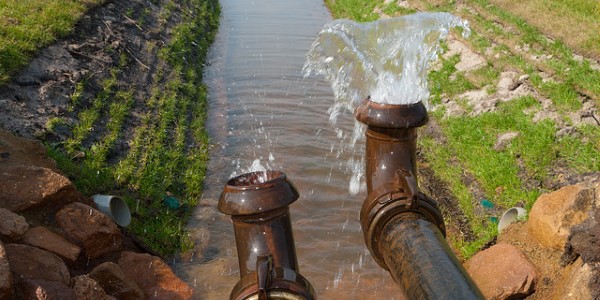Characteristics
Ground water is often neglected in planning, being an essentially invisible resource. However, it is also a shared resource that is high in demand, especially for irrigation and human consumption. That makes it vulnerable to stakeholders who act based on their short-term individual interests instead of long-term communal requirements. Ground water is also particularly vulnerable to pollution. Contaminants from the surface can move through the soil and into the aquifer below, such as pesticides and fertilizers from agriculture, toxic substances from mining sites, and used motor oil and so on. Since ground water can move great distances through underground aquifers, ground water pollution is particularly hard to clean up.
Managing ground water in an IWRM context means balancing the exploitation of the resource (in terms of quantity, quality, and relevant links to other natural resources) with the increasing demand for water for broad economic development and livelihoods. This balance has to take into account efficiency, equity, and long term sustainability in terms of maintaining both quality and quantity at desired levels.
In practice, ground water is often managed separately from: (1) surface water, though it is part of the overall hydrological cycle, both in quantity and quality; (2) urban wastewater, though it simultaneously represents an additional resource and a potential pollution threat to ground water; (3) land management, though aquifers are threatened by pollution from urbanization, industrial development, agricultural activity and mining enterprises.
A ground water management plan should be part of a National IWRM Plan (C4.01) in order to avoid these situations. Thus, the ground water management plan, as the national plan, identifies actions necessary to contribute to an effective water resources management framework. It uses approaches of stakeholder participation (see C3.03) and Capacity Building (B4), sets needs in the wider social and economic framework, and recognises clearly the local hydrogeological, socioeconomic and institutional situation (see Tools C2).
The delineation of appropriate boundaries for the establishment of the ground water resource planning/management area is a particular issue, which often goes beyond political/administrative limits. Also, in some socioeconomic and political real-world situations, risk management decisions – to address excessive abstraction and/or severe ground water pollution – will override integrated management approaches. Other barriers to an integrated approach include: lack of institutional capacity, limited fund availability or, simply, politics.
The ground water management plan should be appropriate to the specific situation:
- In a baseline situation with insignificant ground water abstraction, only registration of wells and springs, and resource mapping, is needed.
- In a situation of incipient stress with few local competing demands and conflicts, simple management tools for well spacing, monitoring and reporting supported by a regulatory framework are appropriate.
- With significant stress, where abstractions impact natural regimes and stakeholders, a ground water development policy and regulatory framework are needed, which should be based on a comprehensive resource assessment.
- In the unsustainable situation with excessive uncontrolled abstraction and irreversible aquifer deterioration there is an urgent need for much more rigorous policies, legislation, regulation, and strong management mechanisms.
Lessons learned
- National food and energy policies can exert an overriding influence on ground water development and management strategies.
- A finely-tuned balance of regulations (in particular on water rights - A2.01), Economic Instruments (e.g. abstraction and Pollution Charges and Tradable Pollution Permits – C7.01; C7.03; C7.04) and incentives to use water more efficiently is required to bring stakeholders into ground water management.
- The effectiveness of stringent reactions to a ground water crisis may depend on how much society is willing to pay for such an approach.
- “Top-down” and “bottom-up” approaches must be reconciled to achieve effective resource planning/management.
- Implementing management measures will often require capacity building, both in water resource authorities and amongst water users.
- Youth Education (C8.01) and Raising Awareness (C8.02) can help communities understand about human impacts on available ground water resources.
- The interactions between agricultural irrigation, surface water, and ground water resources are often very close – such that active cross-sector dialogue and integrated vision are also needed to promote sustainable land and water management.

